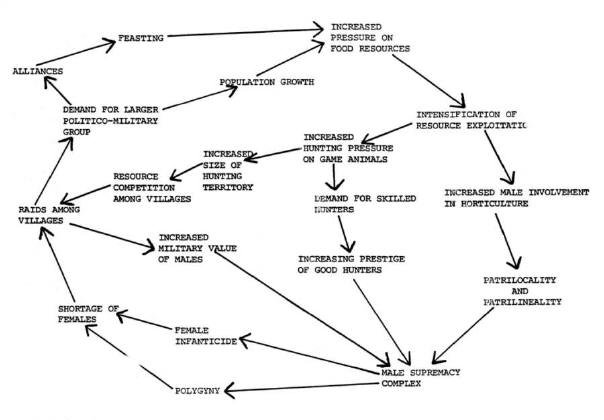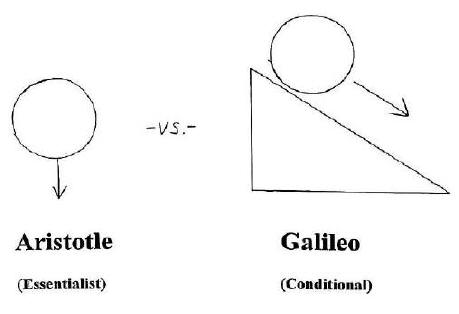Science
and the Study of Anthropology
William S. Abruzzi
(2004)
As a social science, anthropology is concerned with applying the principles of science to the study of social behavior in the same way that scientific principles are applied to other areas of human behavior. However, before applying a scientific approach, it is necessary to understand both what constitutes a scientific explanation and what are the minimum requirements of doing science.
What is Science?
Too often, science is both viewed and taught as an “organized body of knowledge.” However, cookbooks, telephone directories and the Sears Catalogue are organized bodies of knowledge, but they do not represent science. Rather than think of science as an object (a noun); it is more useful and appropriate to think of science as a process (a verb). Science is, therefore a process, not a product. Science is a method of investigation. In other words, “science is sciencing.” The principal distinction between science and non-science, then, is not in the material examined but in the approach taken. Science is the analytical method that attempts to test theories about the behavior of phenomena and that rejects those theories that are either invalid or less accurate than competing theories.
It is not the case that some phenomena are inherently more scientific than others. The study of the circulation of the blood or the motion of the planets is not a priori more scientific than the study of marriage, family, politics or religion. All behavior can be studied scientifically. The motion of stars and planets can be approached scientifically, as in astronomy, or non-scientifically, as in astrology. Similarly, the diversity of life on earth can be explained scientifically through the application of evolutionary theory or non-scientifically through recourse to Biblical creation. We can also approach the detection and treatment of disease through the application of germ theory or explain it by recourse to witchcraft or God's will.
Most aspects of human behavior can also be examined scientifically. Family structure, gender-related behavior, warfare, religious movements, circumcision, infanticide, cannibalism and most other forms of human behavior can be examined and more precisely understood through the application of scientific research methods. However, there are certain fundamental methodological requirements inherent to the scientific process, and those studies that do not adhere to these methods cannot be considered scientific. Unfortunately, much of what passes for explanation in the social and behavioral sciences fails to meet the minimum requirements of science. However, this reflects more a lack of rigor by many social and behavioral scientists than the inability of social science, including anthropology, to be scientific. The physical and biological sciences were themselves at one time all unscientific by today’s standards. However, they all underwent radical changes in their methodology to become the sciences they are generally considered to be today. The beginning of this shift took place nearly 400 years ago with the change from an Aristotelian to a Galilean perspective in physics (see Aristotelian vs. Galilean Forms of Explanation). This methodological shift occurred subsequently in other fields. The Darwinian Revolution in biology may be seen as a shift from an Aristotelian to a Galilean explanation of biological diversity. While some social and behavior sciences have moved in the direction of this shift (most notably in the development of microeconomic theory), considerable resistance persists within the social and behavioral sciences regarding whether the application of scientific research methods to the study of human behavior is either possible or desirable. The perspective taken here is that it is. Indeed, in no field of inquiry have we witnessed a situation where a movement away from a scientific understanding of specific phenomena has led to a better, more precise understanding of those phenomena.
One basic requirement for doing science is that the principal concepts used to explain behavior have both empirical referents and operational definitions: that is, they must be definable in terms of empirically observable phenomena. While we can define the brain and its functions as empirical phenomena, we cannot do the same for the "mind." Similarly, it is not possible to empirically define a culture, “Manifest Destiny”, Patriarchy, the Id, Ego or Superego (Freud), Jungian archetypes, “the will of the people," ”maternal instinct," “the Protestant ethic,” “the Weiteri complex” (the value of fierceness among the Yanomamo Indians) and many of the other explanatory concepts that are used in everyday speech, as well as in many professional social and behavioral science explanations. The relationship between phenomena must also be measurable, because scientific explanations make specific predictions about outcomes. In order to evaluate scientific predictions, they must be testable and refutable (falsifiable). Those predictions that are testable and refutable are considered scientific, while those that are not are rejected as either non-science or pseudo-science.
Another critical component of a scientific explanation is the Uniformitarian Principle: to the extent that a theory or principle is correct, it must be correct everywhere. For example, if the law of gravity applies in Pennsylvania, it must also apply in New Mexico. It, likewise, must apply on the African continent and on the moon, as well as during the Middle Ages and in prehistoric times. The same must be said for the concepts and principles applied to explain chemical, biological and social phenomena. There cannot be exceptions to the theory or principle; rather, exceptions cast doubt on the validity of the theory or principle. The Uniformitarian Principle is absolutely fundamental to science; without it, there can be no science, because individuals could simply claim an exception for those cases that did not fit the theory, or that were of importance to an individual’s worldview. For this reason, the belief in miracles, by definition, violates the Uniformitarian Principle. Romantic views of Native Americans, which see American Indians as living in balance with nature, also violate the Uniformitarian Principle. They essentially claim that these populations were not subject to the same ecological principles that operate among all other human and non-human populations. Those who claim that the rise of Christianity in Palestine during the first century C.E. was a unique event, different from the rise of all other religious movements throughout history, likewise violate the Uniformitarian Principle by claiming that sociological and anthropological explanations for the origin of religious movements can be applied to all but this one movement.
As I just stated, science is based on making predictions. However, prediction should not be confused with prophesy. The fundamental scientific statement is “given a, . . . then b"; that is, given one particular set of conditions defined as “a”, then a subsequent outcome, defined as “b” will occur. Change the conditions in “a” and the outcome “b” will also change. Competing scientific explanations are evaluated in terms of which theory provides the most accurate and complete prediction of the various outcomes. Galileo’s Law of Motion could better explain the various motions of a ball (or other objects) than could Aristotle’s principles and, therefore, replaced an Aristotelian explanation. Similarly, in time, Newton’s Law of Motion explained more different types of motion than did Galileo’s and eventually replaced his law. Scientists, therefore, cannot predict what outcomes will occur in the future (such as what future global temperatures will be, or what and how many species will exist in the future), because they cannot know all of the conditions that will exist in the future to define "a" from which the appropriate theory can predict the outcome "b." The most they can say, using global temperature as an example, is that given the specific chemical composition of the atmosphere in the future, the theories of atmospheric science predict that specific global temperature will result.
Theory is one of the most misunderstood and misused words in the English language. Regarding evolution, President Reagan once famously pronounced, "Well, it's a theory--it is a scientific theory only." A scientific theory is a complicated deductive statement (arguing from the general to the specific) that begins with a set of assumptions, leads to a logically derived set of propositions, which in turn lead logically to specific testable hypotheses. (Hypotheses are simply propositions stated in testable –i.e., measurable- terms.) A scientific theory/explanation, thus, takes the following form:
Assumptions
→
Propositions
→
Hypotheses
→ Conclusions
A simple example will illustrate the point. In constructing his Law of Motion, Isaac Newton began with the assumption that energy and matter are completely different phenomena. He also assumed that only matter had mass (weight), and that only those objects containing mass could be affected by gravity. This led him logically to propose that energy, which according to him had no mass, was not affected by gravity. Two centuries later, Albert Einstein presented his now-famous equation, E=mc2, where E equals energy, m equals mass and c equals the speed of light. Einstein’s theory, thus, began with a different set of assumptions than Newton. In Einstein’s theory, energy did have mass; therefore, energy like other objects is affected by gravity. These two theories, thus, lead to different predictions regarding the behavior of light in relation to a heavy object. The critical test of the two theories was performed in the 1920’s when light coming from distant stars was measured passing the sun during a solar eclipse. Newton’s Law of Motion (his theory) predicted that the light should not bend (because it would not be affected by the gravitational attraction of the sun), whereas Einstein’s theory predicted that it should bend. Einstein’s prediction was the correct one, and this critical test marked the beginning of the replacement of Newton’s Laws of Motion by Einstein’s Theory of Relativity. Other predictions derived from the two theories were compared, and due to its better ability to predict the data accurately, Einstein’s Theory has come to replace Newton's laws as the mainstay of modern physics.
Each test of a scientific theory constitutes an Independent Line of Evidence supporting or undermining the scientific community's confidence in that theory. Einstein's theory does not explain everything, but it explains more than Newton's Theory; thus, physicists have more "confidence" in Einstein's Theory of Relativity than in Newton's Theory of Motion. This same perspective underlies the acceptance or rejection of all theories in science. Indeed, it is the only legitimate basis for evaluating competing theories and explanations. Evolutionary theory dominates the biological sciences for this very reason. There is simply no competing theory that systematically explains so many aspects of life on earth as does modern evolutionary theory (which is a combination of the Darwinian concept of natural selection and Mendelian principles of inheritance). If we begin with the assumption that all life on earth had a common beginning and "evolved" over time in response to local adaptive pressures, we would make very different predictions about the data we would find than if we began with the assumption that all of the existing species were created separately and independently from one another. The widespread existence of vestigial organs throughout nature would make logical sense from an evolutionary perspective; because change is gradual, we would expect to see some organs still present within individual organisms (such as tonsils, appendixes and tail bones in humans), even as those organs are gradually lost to an evolving population over time. However, the existence of such vestigial organs makes no sense to (i.e., they would not be logically predicted by) a theory that begins with the assumption that all species were created separately and independently. Such a theory cannot explain why vestigial organ would even exist. Similarly, assuming that all species have changed through time and have a common origin in earlier species explains: (1) the existence of extinct species documented in the fossil record; (2) the pattern of genetic similarities and differences throughout the plant and animal kingdoms; (3) the minute similarities and differences in the chemical structure of chromosomes among such closely related species as humans, chimpanzees, gorillas, orangutans and gibbons; (4) the fact that the fossil record shows a clear sequence in the origin of fish, amphibians, reptiles and mammals, and (5) thousands of more specific observations too numerous to be included here.. Finally, evolutionary theory explains why it is impossible to even develop a clear definition of species that can be universally applied, supporting the notion that the species is a human construct and not an actual biological entity in nature (see Abruzzi, A Temporary Convenience). It is for this reason that biologists have such high confidence in evolutionary theory and such low confidence in alternative explanations of the natural world, including the Biblical version of creation.
If anthropology is to be considered a social science, then it is necessary that the
same method of evaluating alternative theories and explanations in science underlie the methodology used for testing and evaluating anthropological theory, research and explanation. Competing explanations need to be examined in terms of their underlying assumptions and of the propositions that logically derive from those assumptions. Specific consideration also needs to be given to constructing testable hypotheses by which proposed or competing explanations can be evaluated. This is no less possible in the social sciences than it is in the physical or biological sciences; nor is it any less necessary for determining the legitimacy of competing theories of human behavior. In the absence of rigorous scientific methods, subjective interpretations prevail. Some examples will illustrate this point.
Yanomamo Warfare
Napoleon Chagnon, an anthropologist, studied the Yanomamo Indians living near the Brazil-Venezuela border. The Yanomamo have been actively engaged in warfare for many years, with approximately 25% of the men dying from warfare or warfare-related causes. Chagnon has argued that the principal cause of Yanomamo warfare is the "Weiteri Complex," which promotes male aggression and competition and produces a shortage of women. The Yanomamo raid other villages, according to Chagnon, in order to steal women. There are several problems with Chagnon's explanation. First, one of the reasons there is a shortage of women is that the Yanomamo practice preferential female infanticide. Second, Chagnon states that the Yanomamo never raid another village for women that they are not already at war with. He, therefore, cannot explain why these villages are already at war with one another, leading them to raid each other for women. This violates the principle of Temporality, Hill's first Criteria of Causation. Third, Chagnon's explanation cannot explain the substantial variation that exists in warfare among the different Yanomamo villages. While some villages have been raided 25 or more times in a single year, and have raided other villages in return, many villages have not been involved in warfare (either raiding or being raided) for over five years. The "Weiteri complex" (a constant) cannot explain the incidence of warfare (a variable).
Another anthropologist, the late Marvin Harris, argued that Yanomamo warfare evolved as a population control mechanism. According to Harris, increased warfare placed a premium on having more males in a village and, thus, increased the desire of Yanomamo parents to give birth to boys. This resulted in an increase in female infanticide. With less females in the village giving birth to children, the population growth rate declined. One problem with Harris' explanation is that, according to Chagnon's data, the population of the villages he studied comprised about 200 people around 1900, compared to about 2,000 in 1970 when Chagnon studied them. Their population growth clearly did not slow down, let alone come under control. Also, Harris' explanation is a
Teleological explanation, which proposes the result of a behavior as its cause. Such "functionalist" explanations, which have long dominated anthropology, were rejected in the sciences some 60 years ago. They obviously also violate Hill's first Criteria of Causation.
Besides the individual problems with their respective explanations, both Chagnon and Harris also fail to explain specific developments. As already indicated, the level of warfare is very different among the different villages. Similarly, the level of female infanticide varies sharply from one village to another. In some villages the Male/Female sex ratio for children under 14 is 157/100 while in others it is only 121/100.
I have proposed an explanation that differs sharply from those offered by both Chagnon and Harris (see chart below). My explanation begins with the assumption that, among other consequences, population growth leads to increasing competition over resources among neighboring populations. As populations get larger, it becomes more difficult to obtain sufficient food by hunting, which enhances the prestige of good hunters (who are males). This increased competition also leads to greater conflict among neighboring villages and places, as has been suggested, a premium on the birth of males in a village. Population growth also leads to the intensification of food production by males, which results in both patrilocal residence and patrilineal descent. This further enhances the importance of males among the Yanomamo. The shortage of women in a village now makes sense. The availability of women declines as a result of preferential female infanticide and polygyny (one male having more than one wife). Powerful men are able to make more alliances with other families through marriage. My "theory" leads to specific testable hypotheses. Those villages with the higher population density (Population/Resource ratio) should be the same villages that practice the highest rates of female infanticide and that are the most heavily involved in warfare ("given a, . . . then b"). Villages in the center of Yanomamo territory, according to Chagnon, are twice as large as those located on the periphery of this region (50-250 people in the central villages compared to 25-100 among the peripheral villages). They are also located much closer to one another. Population density is, therefore, much higher among the central villages than among the peripheral villages. According to my model, the central villages should be the most actively engaged in warfare, practice more frequent female infanticide and have the highest sex-ratio imbalances. This is exactly the situation described by Chagnon.

Yanomamo Warfare as a Positive Feedback System
Caused by Population Growth
Thus, examining the logic of Chagnon's, Harris' and my explanations, it is possible to determine in a scientific way which "theory" gives us the best explanation of Yanomamo warfare. The fact that my model can also be applied to explain the spiral of increasing warfare among the Plains Indians during the 19th century (see Gender and Plains Indian Warfare.ppt) adds to my "confidence" in its validity. The Plains Indian situation represents an "independent line of evidence" with which to test my explanation of the causes of warfare among contiguous populations. Given the available data, Occam's Razor, thus, favors an explanation of warfare based on the impact that population growth has on resource competition to an explanation based on cultural values or ecological functionalism.
Overpopulation
Another example, a little closer to home, will also illustrate both the ability and the importance of applying careful scientific methods in social science research. We hear and read constantly about overpopulation in developing countries and how population growth is the cause of these countries' underdevelopment. However, this is only the belief of those demographers who accept what is known as Malthusian population theory. For Malthusians, population growth results in more mouths to feed and, thus, less investment in economic development, as more energy must be spent just trying to feed the growing population. Neo-Malthusian population theory has become accepted nearly as dogma in the West and forms the cornerstone of most environmental studies programs in the U.S.. There is a problem, however, with Malthusian theory. It does not explain the facts. In fact, the data largely contradict the theory.
For example, Sub-Saharan Africa had nearly 100 million people in A.D. 1500, about the same as Europe at that time (even though the African continent is perhaps 7-9 times larger than the size of Europe, making population density in Africa only a fraction of what it was in Europe). However, while Africa’s population declined precipitously following European contact, the populations of Europe and European-derived countries (the U.S., Canada, Australia, etc.) increased dramatically. Indeed, Africa’s population has only rebounded in the late 20th century, but it still comprises only 11% of the world population compared to 17% in 1500. These facts raise several issues relating to the role of population growth in African (and other "Third World countries') underdevelopment. Who prospered more over the past 5 centuries: the people living on the continent whose population size decreased (Africa), or the people living on the continent whose population size increased (North America and Europe)? Africa's proportion of world population has actually decreased during the past 5 centuries. Given the logic of Malthusian population theory, we should expect that Africa as a region would have shown greater (not lesser) economic development than other world regions. Also, since Europe’s population has increased from 100 million in 1500 to about 400 million today, Europe should be showing the negative signs of population growth. Indeed, the population densities of Germany and Great Britain are about twice that of Nigeria, nearly 5 times that of either Ethiopia or Kenya and 30 times that of the Congo! Moreover, per capita energy consumption in Germany and Great Britain is almost 20 times that in the Congo, 42 times that in either Kenya and Nigeria and 240 times that in Ethiopia.
The U.S. population has increased from 75 million in 1900 to nearly 300 million in 2000 --a phenomenal 300% increase between 1900 and 2000! Malthus actually claimed that population growth in the U.S. was unsustainable. Yet the U.S. has become the most prosperous country to have ever existed by almost every measurable criteria. In addition, Japan (the second most prosperous society in the world) experienced a growth in its population from about 35 million in 1900 to over 128 million today --an increase of over 250%. Moreover, since Japan is an island whose surface is largely covered by mountains, it contains a population 1/3 that of the entire U.S. living on a land surface smaller than California. Why aren't the Japanese starving? According to Malthusian population theory, we should see widespread starvation in Europe, the U.S. and Japan. What we have instead is a situation where the most prosperous countries in the world are those that have experienced some of the highest population growth rates during the very period of their most rapid economic development and that have achieved among the highest population densities in the world, while the poorest countries in the world are those that have historically experienced population decline and today have among the smallest and least dense populations in the world.
An alternate non-Malthusian theory of population growth sees population growth, not as a detriment to economic development, but rather as a principle driving force contributing to economic development and social evolution. Population growth, according to non-Malthusian population theory creates a demand for innovation -- the development of new technology, new ways of organizing labor, developing new methods of food production, finding new sources of energy, etc.-- which not only enables a population to survive and adapt, but also to evolve socially and politically. Non-Malthusian population theory better explains why the U.S., Europe and Japan have prospered while the countries of Africa and elsewhere have not. It also explains why China, the world's largest population is currently experiencing the highest rates of economic growth ever recorded and why it is having to close hundreds of thousands of farms because they are producing more food than the country needs. At the same time, it explains why throughout history it has always been those regions that experienced increasing population growth that became the centers of civilization and that ultimately became the regions that prospered and dominated the peoples around them. Civilization has always evolved among growing populations, not among societies whose populations have either stagnated or decreased in size. A significant question then becomes why the West has so readily adopted Malthusian population theory when it has repeatedly been shown not to apply to human populations. Perhaps Malthusian theory serves elite Western interests by blaming the poor (domestic and foreign) for their own poverty and for various social ills, thus legitimizing public policies directed against them (see Abruzzi, Sociopolitical Implications of the Persistent Western Concern with Global Population Growth).
Gender-Related Behavior
This same methodology can be applied to examine gender-related behavior. Numerous conflicting accounts and explanations exist regarding the causes and consequences of gender-related behavior. Some explanations of gender-related behavior are blatantly false as, for example, the American Association of University Women's (AAUW) fraudulent self-esteem study. There are, however, many proposed explanations of gender-related behavior whose methodological problems are not so blatantly obvious or whose validity is not so clearly questionable. Mary Pipher's book, Reviving Ophelia, is a case in point. The following is a quote from Pipher's book (pp.27-28):
Our
minds, which are shaped by the society in which we live, can oppress us. . . .
Adolescent
clients intrigue me as they struggle to sort themselves out.
But I wouldn't have written this book had it not been for these
last few years when my office has been filled with girls: girls with eating disorders, alcohol problems, posttraumatic
stress reactions to sexual or physical assaults, sexually transmitted
diseases (STDs), self-inflicted injuries and strange phobias, and girls
who have tried to kill themselves or run away.
A health department survey showed that 40 percent of all girls in
my Midwestern city considered suicide last year. The Centers for Disease Control in Atlanta reports that the suicide
rate among children age ten to fourteen rose 75 percent between 1979 and
1988. Something dramatic is
happening to adolescent girls in America, something unnoticed by those not
on the front lines.
Many
of the pressures girls have always faced are intensified in the 1990s. Many things contribute to this intensification:
more divorced families, chemical addictions, casual sex and
violence against women. Because
of the media, which Clarence page calls "electronic wallpaper,"
girls all live in one big town --a sleazy, dangerous tinsel town with lots of liquor stores
and few protected spaces. Increasingly,
women have been sexualized and objectified, their bodies marketed to sell
tractors and toothpaste.
Pipher displays a clear bias in her view of American society and in her analysis of adolescent emotional problems. She believes that American society "oppresses" girls. However, she never provides a meaningful (i.e., operational) definition of the word "oppress". Without a workable definition of oppression, it is impossible to accept Pipher's claim that American society oppresses women. Pipher's bias also leads her to make several unsubstantiated statements that are based on a very weak argument and that lack even the minimum data needed to support them. For example, in the above quote, Pipher makes three sequential statements that are made to substantiate her claim that girls are in trouble: (1) she first states that "40 percent of all the girls in my Midwestern city considered suicide last year;" (2) she then states that "the suicide rate among children age ten to fourteen rose 75 percent between 1979 and 1988;" and (3) she then concludes that "something dramatic is happening to adolescent girls in America."
Pipher's argument has several problems. To begin with, she only gives us the percentage of girls in her town that "considered suicide". Without comparable data on boys, the implication of this figure for the relative mental health of girls cannot be determined. Furthermore, the logic of her three sentences does not follow. She begins with a statement about girls considering suicide; follows this with a statement about the suicide rate of children (not just girls) and then concludes with a statement about what this means for girls. Her concluding statement does not follow logically from her first two statements.
Pipher first needs to present comparable data about boys and girls and must show that the data clearly indicate a worse situation for girls than boys before she can conclude that "something dramatic is happening to adolescent girls in America." Furthermore, it is reasonable to ask why Pipher chose to present only the data she used when this data is clearly inadequate and when the data she needed to include in order to substantiate her claim is so readily available. Why, for example, does she only present suicide data for children 10-14 when discussing adolescents? Does adolescence begin at age 10 and end at age 14? Why doesn't she give us suicide data up through, say 19 or older, and why doesn't she give us both male and female suicide data? Could it be that this data completely undermines her entire argument?
The fact is that the suicide data completely contradict Pipher's argument. As the table below clearly indicates, there are four times as many male suicides as there are female suicides in the U.S. Furthermore, the discrepancy has increased through time: 2.42 times in 1970 compared to 4.09 times in 1993. In addition, the proportion of male suicides increases with age: from 2.4 times as many male suicides as female suicides at age 10-14 to 6.1 times as many at age 20-24. Similarly, the homicide rate for males is much greater than that for females. In 1993 over 20,000 males were murdered compared to less than 6,000 females. So the violence towards males (as measured by the homicide rate) is about 3.5 times the violence towards women. Clearly, none of this data supports Pipher's thesis.

It is not only reasonable to ask --it is fundamentally necessary to ask-- to what extent Pipher's failure to present sufficient data was influenced by her bias. She was very selective in the presentation of the facts. She presented only data that supported her argument and ignored the data that did not, even though that data is both voluminous and readily available (I was able to obtain official homicide and suicide data by age and sex from 1950-1993 in less than 20 minutes.) The data clearly show that the increasing violence and suicide has nothing to do with America oppressing women, because it is primarily men being murdered and committing suicide. Therefore, all of her statements about a hostile media exploiting girls and sexualizing them are simply irrelevant to her thesis that these pressures on girls has increased over the last 30 years resulting in a high rate of female suicide and emotional problems. These statements simply don't explain the data. If the factors she emphasizes were the cause of both violence and suicide, we should see more women dying and committing suicide than men ("given a, . . . then b."; see also Hill's "Dose Response"). We should also see the relative number of women being killed and committing suicide increase over the past 40 years faster than the number of men. However, the opposite is the case. The male/female suicide rate in 1960 was 2.57, whereas the male/female suicide rate in 1993 was 4.09. Similarly, the male/female homicide rate in 1960 was 3.17 compared to 3.56 in 1993. In both cases, there has been a faster increase in the death of men since 1960. Indeed, the suicide and homicide data suggest that it would be more reasonable to argue that American society oppresses males.
Clearly, there has been an increase in the number of boys and girls, as well as men and women, dying prematurely, and it very likely is due to the increasing social pressures on both adolescents and adults that have occurred over the past 40 years. However, the cause of this trend may have nothing to do with the kind of popular claims promoted simplistically by Pipher and others. Social policies based on publications like Reviving Ophelia are, therefore, doomed to failure because they obviously target the wrong factors. Several years ago, women's groups circulated a petition titled Taliban War on Women. The petition claimed that the Taliban oppressed women. One of the principal examples of this oppression was that women in Afghanistan were forced to wear the burqa, a piece of clothing that covers a woman from head to foot. However, that petition completely ignored the fact that the Taliban also systematically slit the throats and cut the hand and feet off of thousands of men and boys and hung many men from lampposts in downtown Kabul, treatment far more horrendous than anything directed towards women. This data was ignored because it substantially undermined the claim that Afghan women were being oppressed by men in a "Patriarchal" Muslim society (see Abruzzi, Taliban War on Women). Similarly, there has been considerable outcry in the West against ritual female circumcision in Africa and the Middle East, a practice routinely referred to as Female Genital Mutilation (FGM). No comparable derogatory term is used to describe male circumcision, and no outcry has arisen against that custom, despite the fact that male circumcision is far more widely practiced than female circumcision. FGM is claimed to result in a variety of medical problems and, like the other gender-related behaviors discussed here, is largely attributed to "Patriarchal" social attitudes designed to control and oppress women. These claims ignore not only the fact that male circumcision is far more widely practiced throughout the world and results in its own medical issues, but that female circumcision occurs almost exclusively in those societies that also circumcise males, meaning that it cannot be a practice designed specifically to control and oppress women (see Abruzzi, Circumcision). It is both reasonable and important to ask why such gender-related research continues to be popular and widely accepted, despite its inability to explain the data. Might this research persist and gain an audience for sociopolitical reasons rather than for scientific ones (see Abruzzi, Bias in Higher Education)?
The above examples all illustrate the importance of adopting a careful scientific methodology to the study of human social behavior. The media, the airwaves, the Internet and even professional journals are filled with information and research related to contemporary issues. Some of it is good, but unfortunately much of it is bad (I would even argue that in some areas most of it is bad). This brief webpage has presented the very minimum analytical methods that must be followed in order to critically evaluate available information. It has provided specific examples to show that the scientific method is as applicable to the study of anthropology and the other social sciences as it is to physics, chemistry and biology. One should keep these ideas in mind when reading articles or writing essays and research papers for a course, as well as when reading newspapers, journals and magazines. This is what thinking critically means.
* * * * *
Of Related Interest:
|
Aristotelian vs. Galilean Forms of Explanation: Implications for Explaining Human Behavior
|
|
Why Cultural Anthropology Students Should Learn
A Critical Review of the Species Concept
Scopes, Evolution and Dayton, Tennessee
* * * * *




